#clematis virginiana
Explore tagged Tumblr posts
Text


Native wild clematis, Clematis virginiana, growing along the lake path. I love to see it.
#pennsylvania#flowers#native plants#plants#plantblr#clematis virginiana#wild clematis#virgin’s bower#this is what I thought I was getting when I planted my wildly invasive nonnative autumn clematis
201 notes
·
View notes
Text

Virginia clematis in bloom
#landscape#landscape photography#nature#nature photography#naturecore#photography#garden#flowers#wildflowers#flowercore#clematis#clematis virginiana#virginia clematis#virgins bower#summer#autumn#fall#september#kentucky
38 notes
·
View notes
Text

glad to see my virgins bower is still alive after all its been through.......
#my (native) bush honeysuckle too. lol growing thru the logs. which WILL be gone soon.#me n boy and my grandma did so much weeding outside#v#clematis virginiana
6 notes
·
View notes
Text
Clematis Virginiana - Virgin's Bower
native
Buttercup Family (Ranunculaceae)


Notes: This guy is going crazy covering out front fence, covered in small white flowers. It's seed pods are also very visually interesting and stay throughout the winter as puffs. If any of it's vines touch soil it WILL try to set roots and make another plant, which happened this past year and we though "Sure this is fine" but it wasn't, dear reader, the plant is in control.
#Clematis Virginiana#Virgin's Bower#buttercup family#Ranunculaceae#White#July#In yard#I planted this#Planted 2023#Native#Illinois Native plant#Z19
0 notes
Text




















Walk with me: Mid-summer hike through a Central Appalachian forest. As summer hurtles toward its final explosive act, the forest's living things embrace urgent, primordial impulses triggered by shrinking daylight: to bloom, to seed, to feed, and to reproduce before the killing frost of Autumn shocks the earth into hibernation. In the deep forest, the fetid perfume of decaying fungi signals the countdown has begun. From top: a bumblebee traversing the fanning pink flowers of hollow-stemmed Joe-Pye weed (Eutrochium fistulosum); the maturing red stem and flowers of seedbox (Ludwigia alternifolia), also known as rattlebox and square-pod water-primrose, a very attractive wetlands annual with four-sided seed capsules; cowbane (Oxypolis rigidior), also known as common water dropwort, a delicate, marsh-loving member of the carrot family that also happens to be toxic; Allegheny hawkweed (Hieracium paniculatum), also known as panicled hawkweed, a spindly-stemmed member of the dandelion tribe; the lovely and hallucinogenic fly agaric (Amanita muscaria); a sprawling colony of sulphur shelf fungus (Laetiporus sulphureus), an edible delicacy otherwise known as chicken of the woods; a red eft (Notophthalmus viridescens); white wood aster (Eurybia divaricata); a twin set of common puffballs (Lycoperdon perlatum); the fungal version of suburban sprawl courtesy of orange moss agaric (Rickenella fibula); a gelatinous serving of orange witches' butter (Dacrymyces chrysospermus); a fiery clump of eastern Jack-o-lanterns (Omphalotus illudens); a potter wasp (Ancistrocerus campestris) drinking from the clumped white flowers of virgin's bower (Clematis virginiana); one of my all-time favorite critters, a locust borer (Megacyllene robiniae), taking its nectar fill from flat-top goldentop (Euthamia graminifolia), also known as grass-leaved goldenrod; a green metallic sweat bee (Augochloropsis ?) finding sustenance from parasol white-top (Doellingeria umbellata var. umbellata), also known as flat-top aster; and the intricate purple flowers of tall ironweed (Vernonia gigantea).

#appalachia#vandalia#west virginia#wildflowers#flora#summer#coopers rock state forest#glade run trail#insects#bumblebee#locust borer#potter wasp#green metallic sweat bee#amphibian#red eft#eastern newt#hollow joe-pye weed#seedbox#cowbane#allegheny hawkweed#white wood aster#virgin's bower#flat-top goldentop#grass-leaved goldenrod#parasol white-top#flat-top aster#tall ironweed#fungi#fly agaric#sulphur shelf fungus
176 notes
·
View notes
Text

Clematis virginiana⊹꩜˳·˖✶⋆
#forest pixi#my photo#forest#nature#woodland#fairy#art#magic#summer#enchanted woodland#witchy#autumn#cottagecore#whimsical#whimsigoth#whimsicore#fairytale#flora and fauna#floral#wildflower#native plants#native flowers#dark art#dark aesthetic#spooky cute#spooky season#my photography#plants#flowers#nature photography
42 notes
·
View notes
Text
My Garden Flowers Part 7
All photos mine, unedited.












In order of appearance:
181. Early Goldenrod (Solidago juncea) She's named for flowering earlier than most goldenrods, which tend to flower in late summer to fall, but not all! I've seen others flower earlier.
182. Canadian Fly Honeysuckle (Lonicera canadensis) Wasn't expecting her to flower this year, but there she was in the spring! No berries, though, sadly. Maybe next year!
183. Sweetshrub (Calycanthus floridus) Not pictured as she hasn't flowered yet.
184. Burning Bush (Euonymus atropurpureus) Not pictured as she hasn't flowered yet.
185. Mapleleaf viburnum (Viburnum acerifolium) Not pictured as she hasn't flowered yet.
186. Veiny Meadow Rue (Thalictrum venulosom) Not pictured as she hasn't flowered yet.
187. Wild Hydrangea (Hydrangea arborescens) Not blue like the ones that enchanted me the time I visited my aunt in England, but still very nice.
188. Beggar's Lice (Hackelia virginiana) I didn't plant her and don't keep many now that she's popped up. She's a handsome enough plant but her fruits stick to EVERYTHING and leaves can get sickly from time to time.
189. Boneset (Eupatorium perfoliatum) Not pictured as she hasn't flowered yet and probably won't this year because my landlord cut that area. (:
190. Squashberry (Viburnum edule) Not pictured as she hasn't flowered yet.
191. Snowberry (Symphoricarpos albus) Not pictured as she hasn't flowered yet.
192. Virgin's Bower (Clematis ligusticifolia) Not pictured as she hasn't flowered yet.
193. Largeleaf Waterleaf (Hydrophyllum macrophyllum) In my opinion she should be named for her rhizome rather than her leaf. The leaves aren't that big but the rhizomes are huge.
194. Twinflower (Linnaea borealis) Not pictured as she hasn't flowered yet, but she is spreading in a nice little mat.
195. Alpine bistort (Bistorta vivipara) Not pictured as I haven't got pictures yet.
196. Rough Cinquefoil (Potentilla norvegica monspeliensis) I didn't plant this, but she is there regardless! Not pictured as I haven't got pictures yet.
197. Sweetfern (Comptonia peregrina) Not a fern. The leaves are just kind of fernlike.
198. Sundial Lupine (Lupinus perennis) Not pictured as she hasn't flowered yet. New area for her and we'll see if A) she survives and B) if she doesn't turn out to be bigleaf lupine again.
199. Gray Goldernrod (Solidago nemoralis) Not pictured as she hasn't flowered yet.
200. Blue Vervain (Verbena hastata) She gets fairly tall and the flowers come up at the top.
201. Scarlet Runner Bean (Phaseolus coccineus) Another one that's not native to the area and can't survive the winter, but has been grown here in the summers long before colonization.
202. Tall Cinquefoil (Drymocallis arguta) Very strawberry-like flowers that sit atop the plant.
203. Early Saxifrage (Micranthes virginiensis) Not pictured as she hasn't flowered yet.
204. American Sweetflag (Acorus americana) Not pictured as she hasn't flowered yet.
205. River Beauty (Chamaenerion latifolium) Not pictured as she hasn't flowered yet.
206. Large cranberry (Vaccinium macrocarpon) Don't know if she'll flower again this year, but she did make a couple of berries last year!
207. Heart-Leaved Aster (Symphyotrichum cordifolium) Not pictured as she hasn't flowered yet.
208. Trout Lily (Erythronium americanum) Not pictured as she hasn't flowered yet.
209. Little Sweet Betsy (Trillium cuneatum) This was supposed to be a different species, but that's okay. She's still native to the range I accept. Her leaves have a lovely natural variegation to them.
210. Woodland Phlox (Phlox divaricata) Nice blue flowers that thrive in shady spots.
#blackswallowtailbutterfly#my photos#photography#my garden#garden flowers#native plant gardening#native flowers of Carolinian Canada and USA
9 notes
·
View notes
Text
Materia medica #1: Devil's Darning Needle
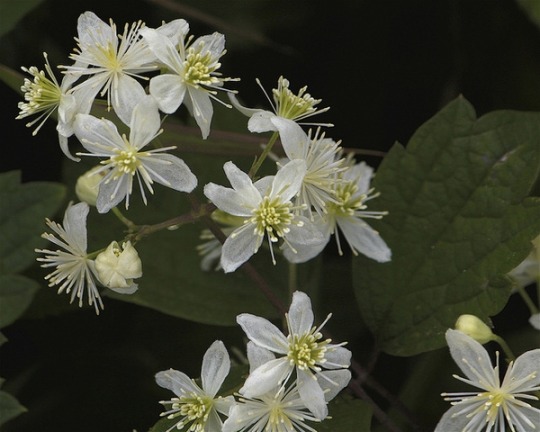
Scientific name: Clematis virginiana; Clematis terniflora
Family: Ranunculaceae
Common name: Devil's darning needle; Old Man's Beard; Virgin's Bower; Woodbine; Traveller's Joy
Description: A vigorous vine bearing flowers with four petals. After flowering in late summer or early fall, the fruit develops into a clump long fluffy strings. Several species can easily be confused, C. virginiana can be identified by having trifoliate leaves. Found near edges: fence rows, stream banks, hedges. When cultivated, may be trained onto trellises, but otherwise will overtake other plants.
Toxicity notes: Poisonous. Do not eat. Sap may cause blisters on skin.
Magical notes: No planetary associations, though one source connects it to Venus/Freyja. UPG: I would call this a saturnine plant due to its choking tendencies, poisonous qualities, and association with the "Old Man."
Folklore notes: A similar Clematis species found in Europe is said to have shaded the Virgin Mary while she traveled, and this lore may have been transferred to the North American species. Others associate it with witchcraft and the devil, though I can't find an explanation for this beyond its habit of smothering other plants. The downy fruit is said to look like a beard, perhaps inspiring the devil connection.
Craft uses: I haven't found anyone else's magical uses, so the following is all UPG. I see binding as the primary use for this plant, especially in baneful workings. For instance, a "stop gossip" spell may include the creation of a poppet that is tied up or the mouth sewn shut using the vine. It may be an asset in workings dealing with the more malevolent side of a love goddess, as it brings together the juxtaposed views of this plant.
[I hope you enjoyed my first materia medica entry. I'm hoping to show not just information on individual plants, but also how you can build your herbal knowledge. If you have any suggestions for what I should add to these entries, let me know!]
Sources
North Carolina Plant Toolbox
Wikipedia
Growsonyou
Virginia Wildflowers
Flowers and Flower Lore
5 notes
·
View notes
Text

8/16/22
#Clematis virginiana#virgin's bower#plant#flowering plant#eucidots#Ranunculales#Ranunculaceae#vining plant
0 notes
Text

clematis virginiana devils darning needles albert fw vick jr, 1988, lady bird johnson wildflower center
1 note
·
View note
Text
I would call this Clematis terniflora. In Northern Delaware it is highly invasive, shutting out native vegetation on a pretty large scale, and often climbing trees and sometimes even bringing them down or killing them. It seems more aggressive here than farther north; it seems to reach its range limits in central PA and it is absent from northern PA and most of upstate NY.
In areas where I pulled this out, I have seen huge increases in biodiversity as native vegetation filled in in its absence. It competes directly with native wild grapes, occupying a similar niche, and also to a degree with the native black raspberries which also have a sprawling, somewhat vining habit, but woody plants and tall herbaceous plants are often much better-able to compete with the native vines than with this one.
Clematis virginiana is native here and I think it would be great if people would plant that species instead of the introduced / invasive one. I would love to pull out all of the introduced one and spread the native one. Again, I don't see it dominate and create problems in the ecosystem the way the introduced one does. It is also more cold-hardy and survives all through northern PA and upstate NY.

It’s weedy

It comes up all over and I pull a lot of it but it’s beautiful and the honeybees visit from far and wide when it’s blooming: Clematis paniculata.
331 notes
·
View notes
Photo

Palouse Falls: Virgin’s bower clematis (Clematis virginiana).
#photographers on tumblr#virgin's bower clematis#Clematis virginiana#Palouse Falls#Palouse Falls State Park#Franklin County#Whitman County#Washington
45 notes
·
View notes
Text
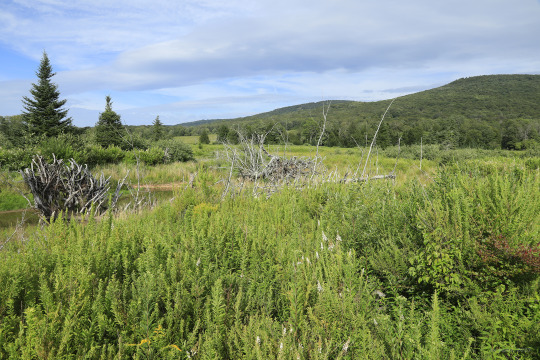



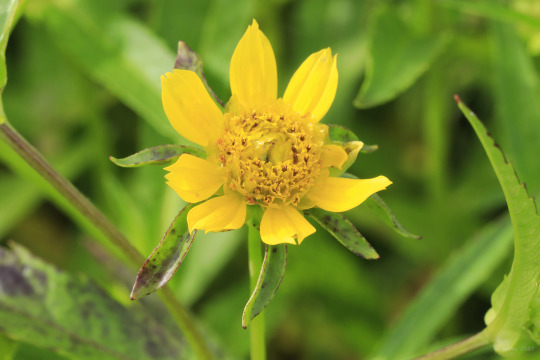

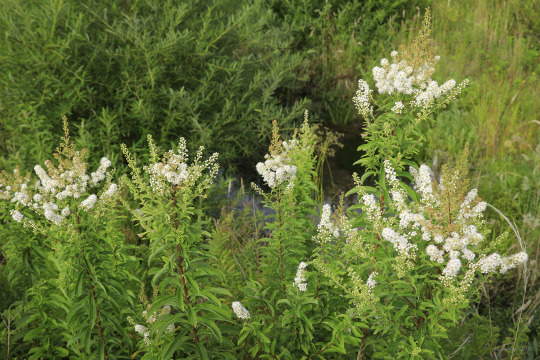


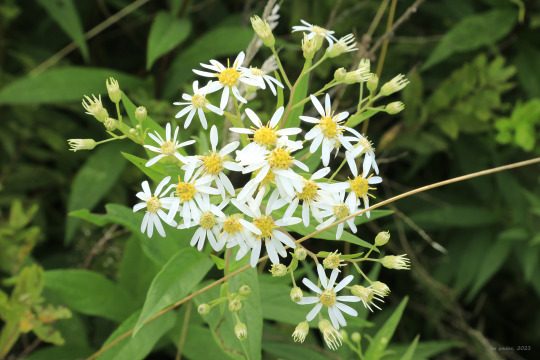

Late afternoon at the balsam fir swamp in Canaan Valley National Wildlife Refuge.
From top: nodding bur-marigold (Bidens cernua), also sometimes referred to as nodding beggarticks, a clumping, wetlands-loving annual whose flowerheads nod as they mature and get heavier; bushy St. John's wort (Hypericum densiflorum), a gorgeous, densely-packed shrub with vibrant yellow flowers and copper-colored bark; white meadowsweet (Spiraea alba), a rapidly-colonizing shrub whose branching clusters of white flowers are one of summer's most generous gifts; narrow-leaved gentian (Gentiana linearis), a tall, elegant bottle gentian that can only be pollinated by bumblebees strong enough to pry open (or chew through) its closed petals; flat-topped white aster (Doellingeria umbellata), also known as parasol whitetop, a tall, attractive mountain aster with flat, branching clusters of white flowers; and the dainty white flowers of virgin's bower (Clematis virginiana), a vigorous, twining vine that forms beautiful, dense waves of foliage and flowers.
#appalachia#vandalia#west virginia#wildflowers#flora#summer#allegheny mountains#canaan valley#canaan valley national wildlife refuge#nodding bur marigold#nodding beggarticks#bushy st. john's wort#white meadowsweet#narrow-leaved gentian#narrowleaf gentian#flat-topped white aster#parasol whitetop#virgin's bower#balsam fir awamp#canaan fir
73 notes
·
View notes
Photo

Clematis virginiana in full bloom! I planted this two years ago. These native clematis grow in such abundance here. I love these plants@ However, if they don't get adequate sunlight they won't flower. I dug this plant up from the field and planted it along the railing of the steps to a friends cabin. It will not be staying here. These clematis produce a lot of seed which allows the plant to spread all over the area. . . . #clematis #clematisvirginiana #nativeclematis #nativewildflowers #wildflowers #wncmountains #blueridgemountains #southernappalachia #upperhickorynutgorge #maker #ilovegardening (at Gerton, North Carolina) https://www.instagram.com/p/CSnhw0AjTo8/?utm_medium=tumblr
#clematis#clematisvirginiana#nativeclematis#nativewildflowers#wildflowers#wncmountains#blueridgemountains#southernappalachia#upperhickorynutgorge#maker#ilovegardening
8 notes
·
View notes
Text

Virgins-bower
Clematis virginiana
Aka. Devil's darning needles, devil's hair, love vine, traveller's joy, wild hops, woodbine, old man's beard
This plant is native to North America where it grows in rich thickets and at the edge of forests.
The Charokee used root tea for stomach and kidney ailments and nervous conditions. The Iroquois used powdered dry root for sore penis and kidney trouble. It was also used to induce strange dreams.
It's toxic.
Sources
Peterson Field Guide to Medicinal Plants and Herbs of Eastern and Central North America 3rd edition by Steven Foster and James A Duke
Wikipedia Clematis virginiana
Wildflower.org
2 notes
·
View notes
Photo

Virgin’s bower, Clematis virginiana
28 notes
·
View notes